Human Orbital Spaceflights
![]()
International Flight No. 90STS-8Challenger (3)8th Space Shuttle missionUSA |
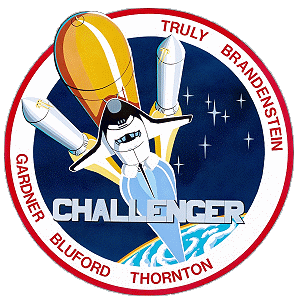 |
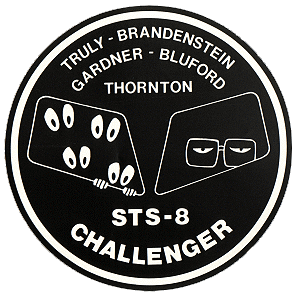 |
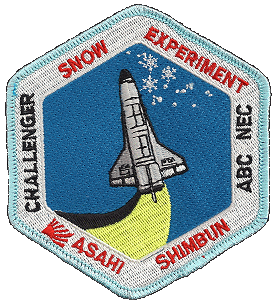 |
||
![]()
Launch, orbit and landing data
walkout photo |
 |
||||||||||||||||||||||||||||
alternative crew photo |
|||||||||||||||||||||||||||||
alternative crew photo |
|||||||||||||||||||||||||||||
alternative crew photo |
Crew
| No. | Surname | Given names | Position | Flight No. | Duration | Orbits | |
| 1 | Truly | Richard Harrison "Dick" | CDR, EV-2 | 2 | 6d 01h 08m 42s | 98 | |
| 2 | Brandenstein | Daniel Charles | PLT | 1 | 6d 01h 08m 42s | 98 | |
| 3 | Bluford | Guion Stewart, Jr. "Guy" | MS-1 | 1 | 6d 01h 08m 42s | 98 | |
| 4 | Gardner | Dale Alan | MS-2, EV-1, FE, RMS | 1 | 6d 01h 08m 42s | 98 | |
| 5 | Thornton | William Edgar | MS-3 | 1 | 6d 01h 08m 42s | 98 |
Crew seating arrangement
|
 |
|
||||||||||||||||||||||||
Hardware
| Orbiter : | OV-099 (3.) |
| SSME (1 / 2 / 3): | 2017 (3.) / 2015 (3.) / 2012 (3.) |
| SRB: | A53/54 |
| ET: | ET-9 (LWT-2) |
| OMS Pod: | Left Pod 01 (3.) / Right Pod 01 (3.) |
| FWD RCS Pod: | FRC 9 (3.) |
| RMS: | 201 (5.) |
| EMU: | EMU No. 1031 (PLSS No. 1005) / EMU No. 1032 (PLSS No. 1006) |
Flight
|
Launch from Cape Canaveral (KSC) and
landing on Edwards AFB, Runway 22. It was the first night launch and
first night landing of a Space Shuttle. An early plan for STS-8, released in April 1982, had scheduled it for July 1983. It was expected to be a three-day mission with four crew members, and would launch INSAT-1-B, an Indian satellite, and TDRS-B, a NASA communications relay satellite. However, following problems with the inertial upper stage (IUS) used to deploy TDRS-A on the STS-6 mission, it was announced in May 1983 that the TDRS was not going to be flown. It was replaced in the manifest by the Payload Flight Test Article. The launch had originally been scheduled for August 04, 1983, and was later rescheduled for August 20, 1983. The requirement to conduct testing with the TDRS system required a delay of ten days for the system to be ready, during which the stack remained on the launch pad. During the on-pad delay, a major tropical storm hit the Florida coastline, making landfall just south of the Kennedy Space Center on the morning of August 25, 1983. The storm had only been identified two days earlier, and there was no time to roll Challenger back from the pad; the decision was made to secure the launch stack and ride out the storm. The primary payload was INSAT-1B, an Indian communications and weather observation satellite, which was released by the orbiter and boosted into a geostationary orbit. INSAT was built by Ford Aerospace's Western Development Laboratories Division in Palo Alto, Calif. Prior to deployment it was carried inside a 3 m (10-ft.)- long sun shield identical to those used on STS-5 and 7 in the aft payload bay of Challenger. A Payload Assist Module (PAM-D) booster built by McDonnell Douglas, of the same type credited with four successes to date, was used to elevate INSAT-1B into geosynchronous orbit at 74 degrees east longitude. In addition to C-band communications capabilities and S-band TV links, INSAT-1B carried a data collection platform to provide weather surveillance and forecasting data and a Very High-Resolution Radiometer for additional weather surveillance data. INSAT-1B, which had a seven-year lifetime, was controlled by the Satellite Control Center located in Hassan, India. The first in this series of satellites, INSAT-1A, was launched into orbit by a Delta booster on April 08, 1982, but was shut down due to failure of the reaction control system. The secondary payload, replacing a delayed NASA communications satellite, was a four-metric-ton dummy payload called Payload Flight Test Article (PFTA), intended to test the use of the shuttle's "Canadarm" remote manipulator system. The Payload Flight Test Article (PFTA), an aluminum, lead-ballasted test structure weighing 3,855.6 kg (8,500 lb.) on earth, was used for the first time during STS-8. It was carried into orbit near the center of the payload bay, and maneuvers involving the Remote Manipulator System (RMS). The test article simulates a large-mass payload for flight testing the arm. The purpose of the tests is to evaluate elbow, wrist and shoulder joint reaction to higher loads and to gain crew experience in operating the 15.2-m (50- ft.)-long mechanical arm. The test article, which is 6 m (19 ft., 9 in.) long and 4.7 m (15 ft., 6 in.) wide, was equipped with two grapple fixtures for the purposes of this mission and will be lifted out of the payload bay by the robot arm. However, it was not be released from the arm, as the test article is a passive satellite, having no control system of its own. When the mechanical arm has lifted the article from the cargo bay, forces were applied through use of the orbiter's reaction control system thrusters. During previous STS missions the capabilities of the arm have been tested alone and with various articles. The first test occurred during STS-2, when the robot arm was operated in all of its modes, ranging from fully automatic to fully manual, although no loads were moved. The STS-3 crew used the arm to grasp an experiment called a Plasma Diagnostic Package, move that unit around both outside and inside the payload bay and return it to its stowed position. The crew on STS-4 utilized the huge arm in the cargo bay twice to lift and swing the Induced Environment Contamination Monitor (IECM) around the payload area to obtain information about particles and gases in the bay that could affect experiments. The arm was tested most spectacularly during the STS-7 mission when it was used to deploy and retrieve the SPAS-01 platform. The SPAS-01 pallet of experiments weighed approximately 1,500 kg (3,300 lb.) The test article, weighing 3,383.8 kg (7,460 lb.) on orbit, more than doubles the weight deployed by the arm on Shuttle flights to date. Scientific experiments carried on board Challenger included the environmental testing of new hardware and materials designed for future spacecraft, the study of biological materials in electric fields under microgravity, and research into space adaptation syndrome (also known as "space sickness"). William Thornton's research into space adaptation sickness noted that the STS-8 astronauts had escaped severe cases, with none suffering loss of motor control; Dale Gardner suffered a "mild case", but was still able to manage effectively, while Daniel Brandenstein - who had suffered from induced motion sickness during training operations - was entirely unaffected. The symptoms were found to abate within three days of launch. The flight furthermore served as shakedown testing for the previously launched TDRS-1 satellite, which would be required to support the subsequent STS-9 mission. The TDRS-1 program was overall less successful, with the satellite suffering several computer failures and an overall loss of telemetry for several hours. In all, the orbiter was able to use the satellite for 65 of the planned 89 orbits, and could make successful use of the connection on about forty. STS-8 marked the fourth time the Continuous Flow Electrophoresis System (CFES) experiment has been flown. CFES, the first commercial project ever carried on the Shuttle, was sponsored by McDonnell Douglas Astronautics Co., St. Louis, Mo., in conjunction with Ortho Pharmaceuticals, an affiliate of Johnson and Johnson. Continuous Flow Electrophoresis was a process of separating biological materials in solution according to their surface electrical charge by passing them through an electrical field. Results of three previous Shuttle flights have shown the device has the ability to separate more than 700 times more material in the weightlessness of space than is possible on earth. NASA furnishes flight time for experimental and precommercial prototype operations as part of its joint endeavor policy, designed to encourage private investment in space industrialization. For the Continuous Flow Electrophoresis experiments on STS-4, STS-6 and STS-7, mixtures of proteins in culture were used. The STS-8 mission is significant because, instead of proteins, live cells were used in the operation for the first time. Because of the difficulties in maintaining the viability of live cells, one of the goals of STS-8 was to demonstrate handling techniques for keeping these cells alive before and after separation. The experiment hardware, situated in the orbiter's middeck, remained the same as in previous flights, except for the addition of a tray on which samples are carried aloft on the surface of microcarrier beads in a fluid compatible with the live cells. Mission specialists transferred the cells to syringes before insertion into the separation chamber. Although no Development Flight Instrumentation (DFI) will be flown during STS-8, the DFI pallet which carried that instrument panel on early flights of the Shuttle Columbia will be used to mount two experiments and two boxes of postal covers in Challenger's forward payload bay. The two experiments are the Evaluation of oxygen Interaction with Materials (DSO 0301) and the High Capacity Heat Pipe Demonstration (DSO 0101). The Evaluation of oxygen Interaction with Materials (DSO) was carried on the instrumentation pallet during earlier missions but was passive, with incident atomic oxygen flux dependent on vehicle attitude. Tests during STS-8 obtained quantitative rates of oxygen interaction with materials used on the orbiter and advanced payloads. The Animal Enclosure Module (AEM) was carried aloft on the STS-8 flight with six rats as residents. The purpose of the test was to demonstrate that the enclosure module is capable of supporting six healthy rats on orbit without compromising the health and comfort of either the astronaut crew or the rats. The enclosure was a self-contained system which could support six rats for more than seven days. Air flows from the orbiter middeck environment into the enclosure by use of fans and were filtered back into the middeck. Food was provided by nutrient bars developed at the NASA Ames Research Center, Mountain View, California. Water was provided by raw potatoes. While on orbit, Challenger made a number of altitude and attitude adjustments, in order to test the behavior of a Shuttle orbiter and to perform some experiments in different thermal conditions. By exposing or shading areas from the sun in an unusual way, it was possible to induce particularly warm or cold conditions and observe any resulting problems |
Photos / Graphics
 |
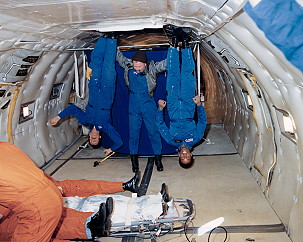 |
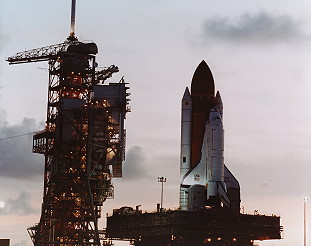 |
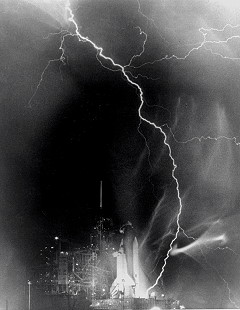 |
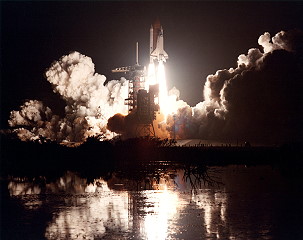 |
 |
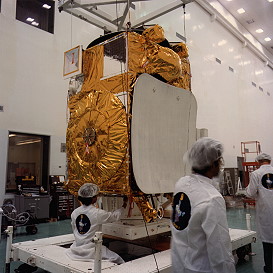 |
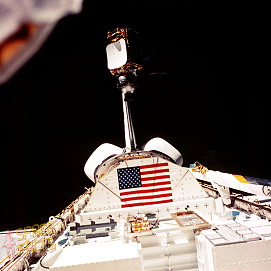 |
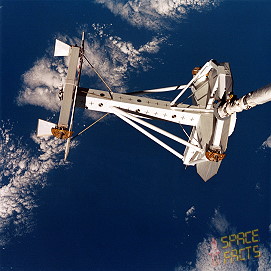 |
 |
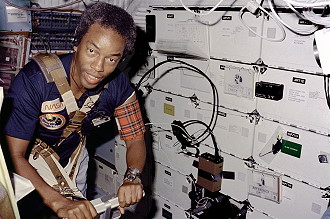 |
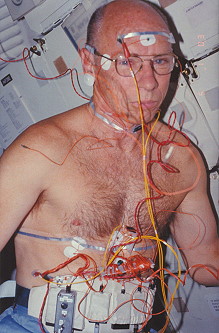 |
 |
 |
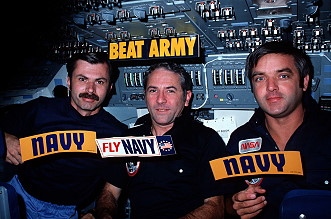 |
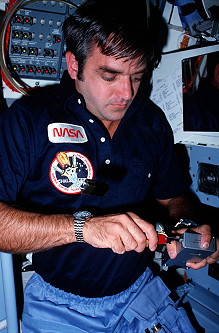 |
 |
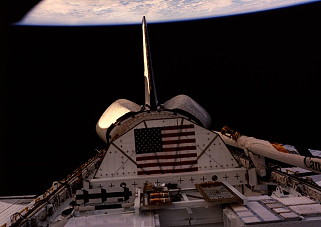 |
 |
|
more Earth observation photos |
|
| © |  |
Last update on March 26, 2020.  |
 |